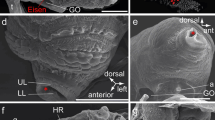Summary
The fine structure of various tubular appendages of the abdomen of aquatic Nematocera larvae was comparatively studied in representatives of 9 families with respect to their possible functions. These appendages are 1. the anal papillae which occur in all aquatic Nematocera larvae, 2. the abdominal tubules of red Chironomus larvae, and 3. the tracheal gills of Liponeura.
The anal papillae of all species studied possess typical transporting epithelia and, therefore, exert an osmoregulatory function as known for larval Culicidae. The presence of tracheoles in the papillar epithelium of some species suggest that they may be additionally involved in respiration comparable to the unspecialized integumental-tracheal respiration. No structural indications were observed which justify the former designations of the anal papillae as tracheal gills or blood gills.
The 5 paired tufts of tubules on the ventral side of Liponeura are densely equipped with tracheoles. Their fine structure is typical of tracheal gills and suggests that they are exclusively respiratory in function.
The abdominal tubules of red Chironomus larvae have very thin epithelia. In one of the species studied the epithelium is only 0.1 to 0.2 μm thick and resembles the respiratory epithelia of vertebrate lungs and gills, suggesting that these tubules serve as blood gills. In the second species studied the epithelium measures ca. 1 μ in thickness. The presence of short microvilli, infoldings of the basal plasma membrane and small mitochondria indicates that, to a small extent and depending on the species, the abdominal tubules are also capable of active transport.
Zusammenfassung
Die Arbeit behandelt die Feinstruktur der Analpapillen von aquatischen Larven verschiedener Arten aus 9 Familien der Nematocera sowie der Abdominalschlauche roter Chironomus-Larven and Tracheenkiemen von Liponeura. Die Analpapillen aller Arten besitzen ein typisches Transportepithel und sind daher wie bei den Culiciden von osmoregulatorischer Bedeutung. Bei einigen Arten erscheint eine zusätzliche respiratorische Funktion durch Hauttracheenatmung möglich. Für eine Deutung der Analpapillen als Tracheen- oder Blutkiemen mit ausschließlich respiratorischer Funktion fehlt die strukturelle Grundlage.
Dagegen sind die ventralen Schlauchbiischel von Liponeura mit ihrer dichten Tracheation eindeutig als Tracheenkiemen anzusprechen, während die Abdominalschlauche der untersuchten roten Chironomus-Larven ein extrem diinnes Epithel besitzen und damit Differenzierungsmerkmale zeigen, die zugunsten einer Deutung als Blutkiemen sprechen, wobei artabhängig in geringem Umfang aktive Transportleistungen hinzukommen können.
Similar content being viewed by others
Literatur
Berridge, M. J., Gupta, B. L.: Fine structural changes in relation to ion and water transport in the rectal papillae of the blowfly, Calliphora. J. Cell Sci. 2, 89–112 (1967)
Copeland, E.: A mitochondrial pump in the cells of the anal papillae of mosquito larvae. J. Cell Biol. 23, 253–263 (1964)
Haas, H.: Der Einfluβ der O2-Spannung des Wassers auf die Entwicklung der Tubuli und Analpapillen von Chironomus thummi. Biol. Zbl. 75, 712–732 (1956)
Haas, H.: Gröβernmodifizierung der Tubuli von Chironomus halophilus und Ch. (Camptochironomus) tentans durch die O2-Spannung des Wassers. Naturwissenschaften 44, 472–473 (1957)
Harnisch, O.: Die physiologische Bedeutung der präanalen Tubuli der Larve von Chironomus thummi. Zool. Anz. 153, 204–211 (1954)
Karrer, H. E.: The ultrastructure of mouse lung. General architecture of capillary and alveolar walls. J. biophys. biochem. Cytol. 2, 241–252 (1956)
Kikkawa, Y.: Morphology of alveolar lining layer. Anat. Rec. 167, 389–400 (1970)
Mashiko, K., Asakura, K.: An electron microscopic study of the anal papillae of the mosquito larvae, Culex pipiens pallens. Ann. Report Note Marine Lab. 8, 19–27 (1968)
Meredith, J., Phillips, J. E.: Ultrastructure of anal papillae from a seawater mosquito larva (Aedes togoi Theobald). Canad. J. Zool. 51, 349–353 (1973a)
Meredith, J., Phillips, J. E.: The ultrastructure of the anal papillae from a seawater mosquito larva, Aedes campestris. J. Insect Physiol. 19, 1157–1172 (1973b)
Meredith, J., Phillips, J. E.: Rectal ultrastructure in salt- and freshwater mosquito larvae in relation to physiological state. Z. Zellforsch. 138, 1–22 (1973c)
Newstead, J. D.: Fine structure of the respiratory lamellae of teleostean gills. Z. Zellforsch. 79, 396–428 (1967)
Nüske, H., Wichard, W.: Die Analpapillen der Köcherfliegenlarven. I. Feinstruktur und histochemischer Nachweis von Natrium und Chlorid bei Phillopotamus montanus Donov. Cytobiologie 4, 480–486 (1971)
Nüske, H., Wichard, W.: Die Analpapillen der Köcherfliegenlarven. II. Feinstruktur des ionen-transportierenden und respiratorischen Epithels bei Glossomatiden. Cytobiologie 6, 243–249 (1972)
Rhodin, J. A. G.: Structure of the gills of the marine fish pollack (Pollachiu, virens). Anat. Rec. 148, 420–434 (1964)
Rhodin, J. A. G.: Histology. A text and atlas. New York-London-Toronto: Oxford University Press 1974
Sohal, R. S., Copeland, E.: Ultrastructural variations in the anal papillae of Aedes aegypti (L.) at different environmental salinities. J. Insect Physiol. 12, 429–439 (1966)
Weibel, E. R., Knight, B. W.: A morphometric study on the thickness of the pulmonary air-blood barrier. J. Cell Biol. 21, 367–384 (1964)
Wesenberg-Lund, C.: Biologic der Süßwasserinsekten. Berlin: Springer 1943
Wessing, A.: Funktionsmorphologie der Exkretionsorgane bei Insekten. Zool. Anz. 31, Suppl.-Bd. Verh. dtsch. Zool. Ges. Heidelberg 1967, 633–681 (1968)
Wessing, A.,Eichelberg, D.: ElektronenmikroskopiseheUntersuchungenzur Struktur und Funktion der Rektalpapillen von Drosophila melanogaster. Z. Zellforsch. 136, 415–432 (1973)
Wichard, W.: Zur Morphogenese des respiratorischen Epithels der Tracheenkiemen bei Larven der Limnephilini Kol. (Insecta, Trichoptera). Z. Zellforsch. 144, 585–592 (1973)
Wichard, W., Komnick, H.: Feinstruktur und Funktion der Analpapillen aquatischer Schwebfliegenlarven (Diptera Syrphidae). Ent. Germ. 1, 1–10 (1974a)
Wichard, W., Komnick, H.: Structure and function of the respiratory epithelium in the tracheal gills of stonefly larvae. J. Insect Physiol. 20, 2397–2406 (1974b)
Wichard, W., Komnick, H.: Feinstruktur und Funktion der Analpapillen aquatischer Käferlarven (Coleoptera: Elodidae). Int. J. Insect Morphol. Embryol. 3, 335–341 (1974c)
Wigglesworth, V. B.: The principles of insect physiology. London: Methuen 1965
Author information
Authors and Affiliations
Rights and permissions
About this article
Cite this article
Komnick, H., Wichard, W. Vergleichende cytologie der analpapillen, abdominalschlauche und tracheenkiemen aquatischer mückenlarven (Diptera, Nematocera). Z. Morph. Tiere 81, 323–341 (1975). https://doi.org/10.1007/BF00298491
Received:
Issue Date:
DOI: https://doi.org/10.1007/BF00298491




